

Information Technology (IT) Pioneers
Retirees and former employees of Unisys, Lockheed Martin, and their heritage companies
Locations, Chapter 30
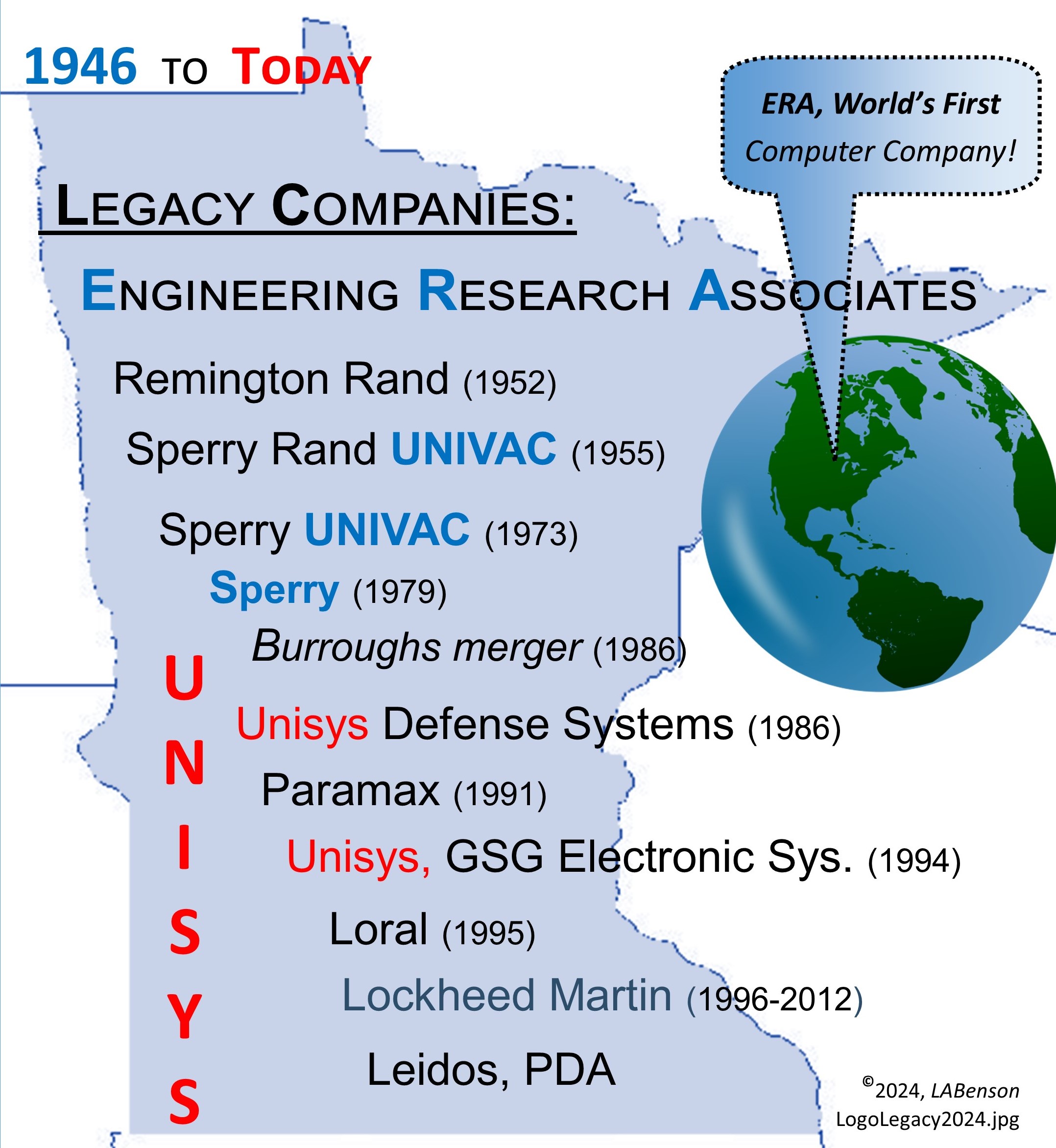
1. Introduction
This chapter tells about the original Engineering Research Associates (ERA) facilities. Although the primary threads of our Legacy are in Minnesota, systems and field support teams have worked at customer sites throughout the world.
- The Twin Cities chapter 31 discusses the other plants in and around the local environs, using Univac plant numbers which superseded ERA numbers. At the time that Burroughs bought Sperry to form UNISYS, there were 28 facilities in the 5 county area around the Twin Cities environs.
- The United States chapter 32 covers the Technical Services Division (TSD). It also has a listing of previous marketing office sites.
- The International Sites chapter 33 identifies out-of-country locations.
- Blue Bell chapter 34 has stories provided by our sister retirees' organization.
-
 We developed Navy computer manufacturing operations in Clearwater
FL - now a Lockheed Martin facility. As of 2022, no one had volunteered to provide details
of that facility.
In September 2023:
The Computer History Archives project posted https://www.youtube.com/watch?v=i2Et8oIo-f8.
This is a 1975 story about the Clearwater manufacturing facility using info from the Hagley museum archives.
We developed Navy computer manufacturing operations in Clearwater
FL - now a Lockheed Martin facility. As of 2022, no one had volunteered to provide details
of that facility.
In September 2023:
The Computer History Archives project posted https://www.youtube.com/watch?v=i2Et8oIo-f8.
This is a 1975 story about the Clearwater manufacturing facility using info from the Hagley museum archives. - We developed Air Force computer manufacturing operations in Pueblo CO - now closed. As of 2024, no one has volunteered to provide details of that site.
- St. Paul Manufacturing Operations is yet an 'under development' chapter 37!
- Winnipeg Operations chapter 38 provides the history of that facility, the people, and their products.
2. Original ERA Buildings
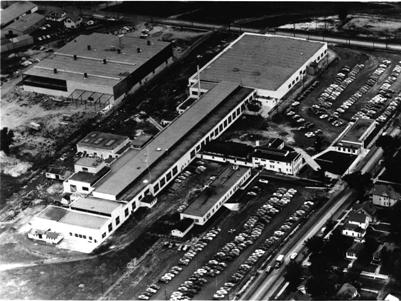
ERA's first 'public' product was a 1950 book reporting the breadth
of US computers being developed in the late 40's. Thanks to the
Charles Babbage Institute, there is a 'reprint' available -
ERA High Speed Computing Devices Report.
Keith Behnke's career summary in the People, A-B
chapter has his
recollections about the Twin Cities plants including these original
ERA facilities. [lab]
2.1 Overview by Lowell Benson:
The first ERA facility was at 1902 Minnehaha Avenue in Saint Paul, a WWII glider factory. In this photo Minnehaha Avenue diagonals the lower right corner from East to West while Prior Avenue cuts across the top of the photo from South to North [left to right]. The two parking lots are separated by the guard building next to Minnehaha and the two story main office building. NSTR was in this two story building. During the 70s, Plant 2 was primarily an environmental testing facility.
The smaller adjacent building by the lower parking lot was called building 6. Building 6 had an extra set of fencing to provide security for the classified projects therein. I remember taking a 'polygraph' test in that building as part of receiving a need to know security clearance (Special Intelligence.) The project that required that special clearance is not open for discussion. [lab]
{Editor's Note: The building in the top left hand corner of this
snapshot would later become UNIVAC plant 5.
2.2 'Commemorated' by Richard Lundgren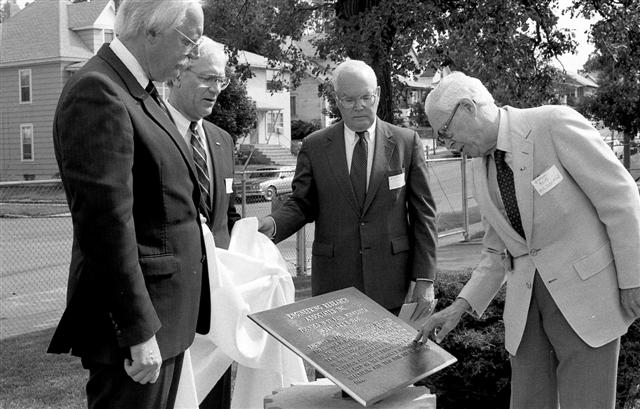
While visiting the Minnesota Historical Societies archives, I found a relevant newspaper article:
St. Paul Pioneer Press. In the 1986 index, I looked up Engineering
Research Associates and found an article 8/20/86 about the 40th anniversary
of ERA. Then I went to the microfilm for that newspaper and was able
to read the article which included a photo of Rolland Anderson, Bill
Geiger, Bob MacDonald, and Jack Nichols unveiling the plaque at Plant
2. It also contained the exact wording on the plaque which is:
"Engineering Research Associates, the forerunner of Sperry's Minnesota
presence, is the acknowledged parent of some 100 Twin Cities computer
firms. In commemoration of the 40th anniversary of ERA's founding, this
plaque is placed on the company's original manufacturing site this 19th
day of August 1986." [rfl]
We had a special stone/concrete "structure/monument" built - it stood
about 36 inches tall. The plaque was mounted on top of this monument.
[Tom Lindquist]
Unfortunately, this plaque disappeared in the 90s. In 2023 the Ramsey County Historical Society put a new plaque here - See Spinoff chapter
Spinoffs, Chapter
6 (vipclubmn.org).
2.3 Recollections by Harry Wise:
When I first came to Remington Rand Univac in 1956 there were still Crosley parts tucked into corners around the old plant.
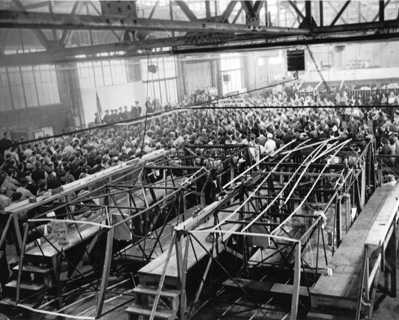 Some time in the 1950's I was working very late and went down for
a coke. Out of the darkness an old guard appeared and we got to talking
about the plant. It seems that the guard was raised in the neighborhood.
That whole area, all the way over to University Ave. was the world's
largest mule auction site during World War I. The army was buying mules
for the war. He remembered walking a trail across the area after the
war. About 1938 they built the present building as a radiator foundry.
They melted iron and pored cast iron radiators.
Some time in the 1950's I was working very late and went down for
a coke. Out of the darkness an old guard appeared and we got to talking
about the plant. It seems that the guard was raised in the neighborhood.
That whole area, all the way over to University Ave. was the world's
largest mule auction site during World War I. The army was buying mules
for the war. He remembered walking a trail across the area after the
war. About 1938 they built the present building as a radiator foundry.
They melted iron and pored cast iron radiators.
Northwest Aeronautical took over the foundry operation during WW II and built gliders in the building. In 1956 you could see all sorts of overhead tracks still in place that were used to move glider parts around the plant. At that time a significant part of the building still had dirt floors. Last time I was in the building you could still see the place that the stacks went through the ceiling in the high part of the building in the south west corner. There was a ceiling about 12' under the roof itself. At one time we installed a radar in a room on that steel ceiling under the roof. The antenna was on a 55' tall tower next to the building.
{Editor's note: At the right are the frames for two gliders, photo
from the early 40s provided by Tim Wandersee.}
![]()
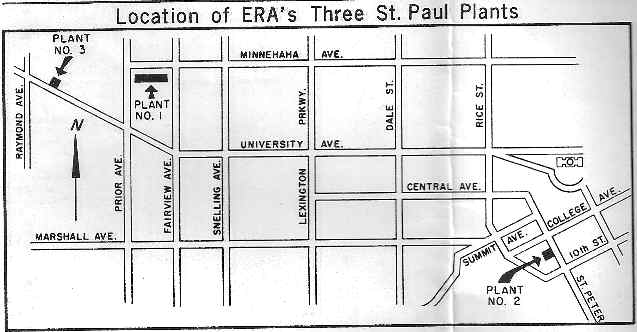 2.4 Other ERA Buildings
2.4 Other ERA Buildings
Engineering Research Associates grew out of their original building so they leased space elsewhere, the Minnehaha facility became their Plant No. 1 as labeled in the diagram at the left.
Their plant 2 facility was in down town St. Paul, primarily for manufacturing electronic devices.
Their plant 3 was along University Avenue, primarily for antenna coupler manufacturing.
ERA also rented space in Griggs Building at University and Fairview for a period of time, referring to it as Plant 4 - not to be confused with the later UNIVAC Plant 4 in Roseville. [lab]
2.5 The
Closing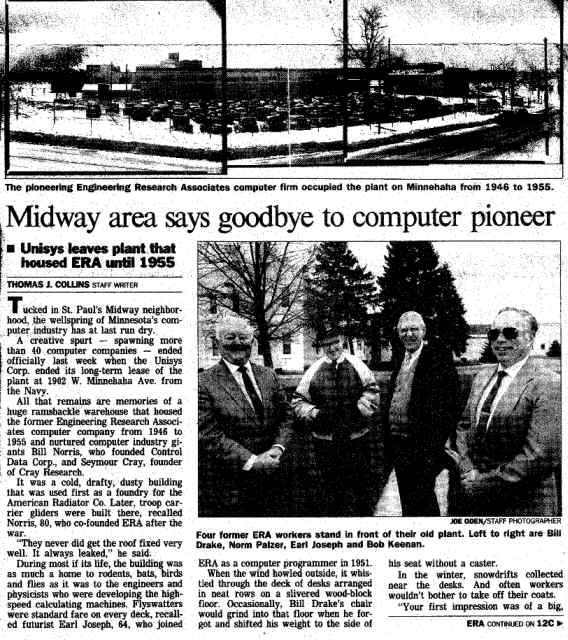
This newspaper article was scanned from a copy of the Saint Paul Pioneer Press dated 10 May, 1991.
The item was contributed to the Legacy project by Ed Nelson.
2.6 Arlington, VA
Copied from the Oct 24, 1952 Orbit newsletter: "A major step in the establishment of an ERA Computing Center was made recently with the leasing of a new building in Arlington, Virginia. Giving ERA an additional 3750 square feet of floor space, the building will serve as temporary quarters for the Computing Center while plans for construction of a permanent home are expanded. The stone fronted building at 555-561 23rd Street South is near the regular Arlington office which will remain in its present location. ERA, as first occupants, will take over the newly completed building on November 1."
"Already under construction in St. Paul's Minnehaha Street plant is the ERA 1101, scheduled for delivery next July. The period from now until actual operation of the computer begins will be used for training personnel and studying typical problems."
In 1953 Don Ream was recruited by Remington Rand Univac to be technical manager of their Arlington, Virginia, ERA 1101 computer center. However, in 1955 Lieutenant Alfred Bettis managed to recruit Ream back to Navy civilian service in the BUSHIPS Computer Design Section at the Navy Security Station. [from Wikipedia by Harvey Taipale.]
3. NSTR
3.1 Comments from Ed Michaud
Cmdr. Joe Hatfield preceded Capt. Swensen as the resident Navy Officer and was known as the BuShips Tech Representative. 1902 West Minnehaha Ave was originally known as Plant No. 1, prior to the construction of the Shepard Road facility.
Rent on Plant 2 at least back in 1955, was based on a the number
of direct labor hours per month being expended by ERA/Univac Personnel
in that facility. As more and more overhead functions were becoming
housed in Plant 2 the Government Accounting Office, GAO, decided they
had better go to a square foot, Gross Lease, approach.
![]()
Ahhh yes, those were the good old days. Ed Michaud
3.2 NSTR by Ben Nilsson, NavSea Technical Representative
When I left NSTR in 1997, I had a couple of files marked “NSTR History” in my file cabinets, there was also information in our office safe. Since Bob Ryan was the last one to leave NSTR, he may know what happened to these files. If not, our office was the responsibility of the Unisys Facility Manager [I don’t remember his name.] Our safe would probably have gone to the Security Dept. Some documents were still classified as Secret. It would be worthwhile to try to find this information.
Engineering Research Associates (ERA) was an outgrowth of a WW-II Navy Lab in Indianapolis, Indiana. As I recall the lab was chartered to develop machines [analog computers] to break the enemies code during WWII. This effort continued after the war and a struggle developed over how it would continue and who would be in charge. Names that I remember are Bill Norris, Seymour Cray, both were Navy Reserve Officers, both later went on to start CDC. {Editor's note: Seymour Cray was never in the Navy.} Another Navy Reserve Officer was Joe Stoutenberg [Univac.] The details of the creation of ERA was in the files in my office and our safe.
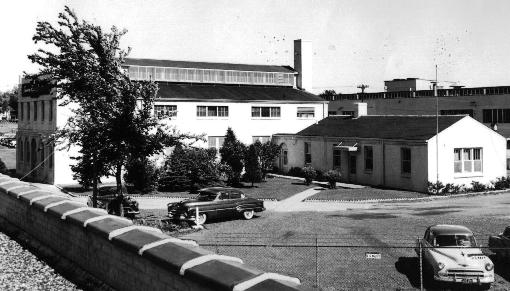 ERA was located on property owned by the Navy, Navy Industrial Reserve
Plant (NIRP)-196. The Navy already had a presence at NIRP-196 before
1946. In the early 1940’s there was a contingent of about 40 military
personnel there to monitor the quality of the WWII Gliders that were
being built there. These gliders were used as tow-able personnel carriers
to get more troops to the front lines. I think the fact that there was
a Navy presence at NIRP-196 played a part in establishing ERA in St.
Paul.
ERA was located on property owned by the Navy, Navy Industrial Reserve
Plant (NIRP)-196. The Navy already had a presence at NIRP-196 before
1946. In the early 1940’s there was a contingent of about 40 military
personnel there to monitor the quality of the WWII Gliders that were
being built there. These gliders were used as tow-able personnel carriers
to get more troops to the front lines. I think the fact that there was
a Navy presence at NIRP-196 played a part in establishing ERA in St.
Paul.
Capt. Eric Swenson was the resident Navy Officer in the 1950’s,
I don’t know when the office became known as NavSeaTechRep (NSTR). He later was transferred to NavSea Washington, D.C. to head up the Navy’s
computer efforts. He knew the bureaucracy of Wash., D.C., so he gave
NSTR a lot of authority in the letter of assignment (LOA). We were essentially
invisible from a chain of command point of view, Capt. Swenson’s
civilian counterpart was Don Ream.
Initially I believe that NSTR was involved with both the development
and quality acceptance of NavSea products. We were not usually involved
with NavAir or Submarine projects. The quality responsibility was later
transferred to DCAS. I believe that the first NavSea computer was the
USQ-17, followed by the CP-642A/B, UYK-7, UYK-20, UYK-43, UYK-44, and
the UYQ-70. Peripherals including the magnetic tape units; DEAC and
RD-358, and analog to digital converters; KCMX and ICKCMX.
Univac/NSTR got involved with the refurbishment business after
the USS Forestall fire in the late 1960’s. Tom Rettler was the
Univac Program Manager. Univac/ NSTR was involved with the CP-642A/B
Expanded Address Modification (EAM) design and retrofit. In the late
1970’s, NSTR was involved in the Iranian DDG-993 software development
at the Univac Corporate Square facility in Eagan.
NSTR was responsible for managing the facilities of NIRP-196 [Univac Plant
2.] Which included the ERA building. At one time there was a plaque
in front of the building [I don’t remember the inscription.] Univac
rented plant 2 from the Navy for $1.00 a year plus maintenance. Plant
2 was about 11 acres and housed the Environmental Test Labs, Manufacturing,
Refurbishment, Navy Software Library, Military Equipment Test Center
(METC), NSTR, and Army Security Agency Laboratory [building 6.]
![]()
The end of NSTR started when LT. Roger Morey [NSTR] invited the
UNISYS General Manager, Al Zettlemoyer to the NSTR Christmas party.
Roger gave Zettlemoyer a tour of the facilities. Zettlemoyer’s
comment was “what is Univac doing in a dump like this”.
Unisys subsequently did not renew their contract for plant 2, and started
moving out. With no tenant, NavSea decided to sell plant 2. Unfortunately
NSTR was getting their entire personnel funding from NavSea for managing
NIRP-196. So, no more money for NSTR. To expedite our demise the Navy
pulled both of our military billets, so NSTR was only comprised of civilian
billets. NSTR had to come up with a reduction in force plan before finally
getting NavSea program money funded thru NSWC at Crane Indiana, to pay
for our salaries. Towards the end Dave Watson [PMS-408] was paying for
the three civilians who were left: Bob Ryan and myself in Eagan and
Bill Schmidt in Clearwater, Florida.
I am giving you a list of names of people who I believe can give
you more details. I would speak with Chuck Alcon [NSTR in the late 1970’s.]
He worked very closely with Don Dunn [Univac Navy Program Manager],
and he has a photographic memory. Don Dunn was Univac’s Program
Manager for NavSea products for many years. I believe that he came from
the Navy Lab in Indianapolis. He was a great promoter and would organize
ceremonies/ parties for any significant event. He would always have
the Univac photographers document the event by taking pictures. There
should be a large photographic record around someplace.
I hope that this will be of some help. Ben Nilsson
| Navy Personnel : | Univac Personnel: |
|
Capt. Eric Swenson – NSTR/NavSea NTDS Development -
Capt. Don Leichtweis - NSTR LCDR Chuck Alcon - NSTR LT. Ronald Helsley - NSTR Don Ream – NavSea Computer Development Joe Mallonee – NavSea Program Manager Ron Goodling – NavSea Program Manager Lee Wallace – NavSea Program Manager Dave Watson – NavSea Program Manager Herb Baker – NavSea Program Manager George Badman – NSTR Chief Engineer Bob Ryan – NSTR Software Specialist, also worked on the Iranian program |
Dick Seaberg - President Don Dunn – Navy Products Program Manager Joe Coughlon – Univac’s NavSea rep. in Washington, D.C. Joe Stoutenberg - Software Engineering Harry Morrison - Program Management Dave Duncan - Program Management Tom Rettler – Program Management Don Mager – Computer Engineering Director Garyld Harms – Field Engineering Gene Achterberg – METC Supervisor in Plant 2 Gene Bauer – Navy Software Library Supervisor in Plant 2 Al Arndt – Mechanical Design Engineer Don Shore – Mechanical Design Engineer Bob Myller – Peripheral Equipment Design Engineer Al Kaszynski – Analog to Digital Converter Design Engineer Jerry Green – Univac parts expeditor Floyd Pnewski – Univac parts expeditor Jim Kruger – Univac parts expeditor |
In this Chapter
1. Introduction
2. Original ERA Buildings:
- Overview by Lowell Benson
- Commemorated by Richard Lundgren
- Recollections by Harry Wise
- Other ERA Buildings
- The Closing
- Arlington VA
3. Navy Systems Technical Representatives (NSTR)
- Comments by Ed Michaud
- Description by Ben Nilsson
Chapter 30 edited
7/8/2025.